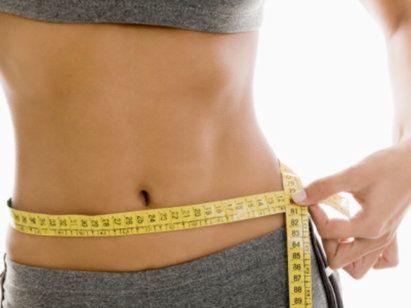Updated February 2022
Body composition is a term used to describe the percentage of fat and muscle in your body. If you want to know how close you are to your desired weight, or if you need help getting started on a fitness plan, it's important that you understand what body composition means. In this blog post, we will talk about 4 different ways that fitness centers measure body composition so they can provide their members with accurate information about their progress.
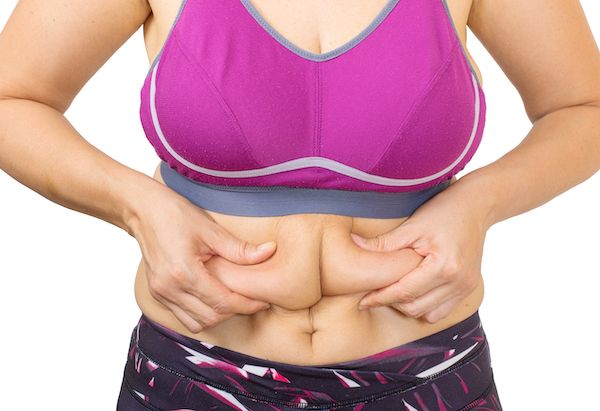
What is Body Composition and Body Fat Percentage?
Body composition measures the proportion of fat and muscle in your body. It can be measured by different methods, including skinfold thickness measurements, bioelectrical impedance analysis (BIA), underwater weighing, dual-energy x-ray absorptiometry (DXA), or air displacement plethysmography.
Body fat in the fitness industry is often a controversial topic. However, measuring body composition can be a powerful way to engage individuals with a personal training program, demonstrate progress, and retain members with the right tool.
In this article, we will discuss the pros and cons of popular body composition methods and what they may mean for you! These methods have been validated either with respect to each other or with respect to an MRI. Since there's a ton of misinformation about accuracy and gold standards regarding body composition, it may be helpful to review them here before getting started.
If used correctly, all these body composition testing are commercially viable methods that can get within a ballpark estimate of an MRI with some as close to 2-3%.
In this blog post, we will break down the science, the user experience, and ROI of how to measure body composition in a fitness center using both traditional techniques and newer technologies that are becoming more popular for determining the total percentage of lean mass, fat mass, and bone density. With this guide, we aim to give you a more in-depth look at how to properly approach body composition assessment in order to achieve a healthy body composition overall.
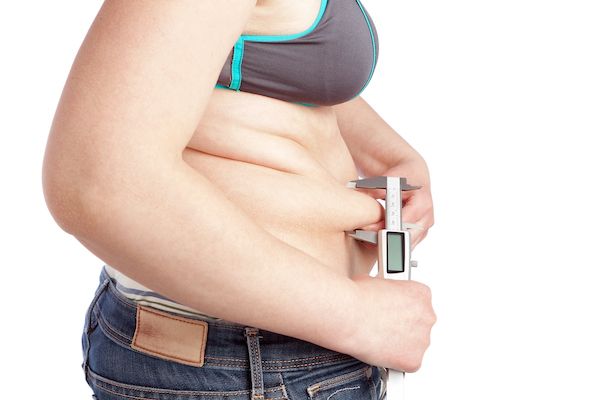
1. Skin Calipers
We all know this one. Those old "trusty" calipers. You're not impressing anyone when you pull those out of a drawer. Even though they lack the sophistication of modern techniques, they still get a lot of play today. Why? Because of their size, ease of use, and frankly, they're cheap! Plus, they're also one of the more commonly used methods by trainers and athletes to measure body fat percentage.
With that said, you literally get what you pay for! Don't be fooled, though, because it's easy to make mistakes. Skin calipers tend to be less accurate when measuring subcutaneous fat in women. Depending on the operator, they can also vary significantly in results--just pinch someone (who's clearly losing fat) in a different spot on a follow-up. All of a sudden, it looks like their body fat went up! So, if you're going to use this technique, make sure the person taking the measurements is well trained and knows what they are doing.
How it works:
Using the caliper's tong-like features to pinch the skin in specific places, a licensed professional (recommended) or individual will record the relative thickness of the skin fold. The areas selected for measurement are sex-specific as fat is stored differently in the human body of males and females. Chest, abdominal, and thigh are skin sites measured in men, while triceps, waist, and thighs are the focus sites for women. The recorded data is then calibrated to a specific formula, resulting in the total body fat percentage.
The Science:
The caliper method rests on the assumption that 50% of body fat rests under the skin. With skin calipers, a proper skin fold assessment is a must as measuring the thickness of skin folds where fat is most prevalent in the body will tell you how much fat to lean mass an individual has.
Pros: Calipers are by far the cheapest and most portable way to track body fat percentage and estimate body composition.
Cons: While it is a cost-friendly and straightforward option for measuring body composition, calipers are most prone to human error. Consequently, they have difficulty tracking precise body fat changes over time. To get accurate and precise results, you need to be extremely careful in measuring all the different body parts, which is time-consuming and labor-intensive. Additionally, you also need to ensure the same person is measuring your client throughout their journey to ensure consistency. With all these constraints, expect a margin of error of 10%.
User Experience: Nobody likes getting pinched. Period. Also, your wellness customers, obesity patients, or fitness members have come to expect at least a minimum level of technology when it comes to assessment, especially with the advent of wearables and other fitness trackers. You're not impressing them by pressing them.
ROI: Although they're cheap, there isn't a ton of value here. If you measure incorrectly, you could lose customers, and in turn, lose money.
Bottom line: Look elsewhere. It's time to invest in some technology.
Our Grade: D-
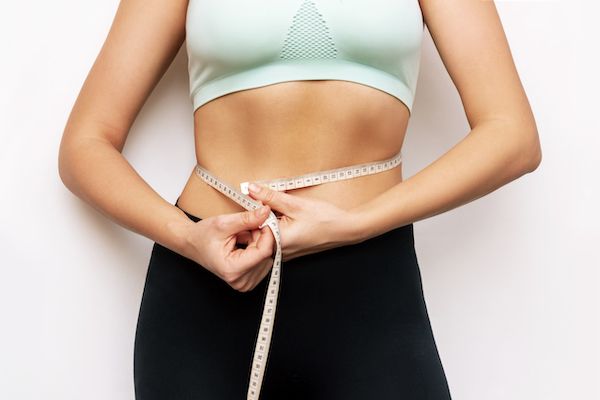
2. US Navy/Circumference Method:
Another common and cost-effective way to measure body composition is using a tape measure to calculate circumferences in regions where body fat resides. In fact, the method is so common that the entire US Armed Forces uses this method in measuring body composition. Like calipers, the idea is relatively straightforward: as people gain body fat, they tend to expand in various body regions. Nonetheless, unlike calipers, there's no pinching involved. However, using the tape measure can be uncomfortable for your member or patient. Sometimes, however, the biggest problem is a lack of repeatability, owing to the difficulty of repeating a location when taking a measurement.
The Science:
The US Navy or circumference method relies on running specific body measurements through a highly developed formula to produce body fat percentage. These measurements are taken manually at the abdomen and neck for men and women's neck, waist, and hips. During its research and development stage, this formula was calibrated using data from DEXA scans and, when administered correctly, is said to produce the same amount of accuracy.
How it works:
Body measurements are taken manually at the designated body parts with measuring tape. This measurement process is then repeated three times. The average of the three-body composition measurements taken at each spot is then input into a formula to calculate the individual's total body composition.
Pros: Very easy to use and administer on-site. The formula is highly reliable when done correctly.
Cons: Prone to human error as the method relies on taking measurements manually. Tilt the tape measure slightly, or add a bit of slack, and you'll find extremely varying results. In some circumstances, the margin of error may reach 10% simply owing to a human mistake in tape measurement.
User Experience: Pretty painless experience for most but can be time-consuming. This approach may not be very pleasant for those who don't want to be touched during an assessment, especially because each measurement must be repeated three times. That's a lot of touching!
ROI: A powerful method, but not much ROI if you measure incorrectly.
Bottom Line: The science is sound, but the instrumentation is lacking in sophistication. If paired with digital circumferences, like those from body scanners, then this method can be the new gold standard, and for that alone, it gets a better grade than skin calipers.
Grade: C

3. Hydrostatic Weighing:
Commonly referred to as the "dunk tank", this is another old-school method for measuring entire body composition. But unless your clients are looking for a deep-sea adventure, then this might not be the best experience for your patients. The body composition results yielded by hydrostatic weighing are pretty accurate. BUT, the space requirements are impractical. Often, third-party companies will drive around trucks with a dunk tank inside and charge a fee for the assessment. And on top of that, trying to convince members to get wet is not an easy challenge to overcome.
How it works:
An individual is weighed on dry land and then is asked to sit submerged entirely underwater. The individual will then expel as much air from their lungs while their underwater weight is taken. The underwater weight is then compared to dry land weight and, using a specific formula, determines a person's body composition.
The Science:
Hydrostatic weighing is based upon the Archimedes Principle, which says that the buoyant force on a submerged object is equal to the weight of the fluid displaced by the thing. In other words, denser material (i.e., lean muscle and bone) will weigh more underwater than less dense material (i.e., fat tissue). Pretty smart, eh?
Pros: Hydrostatic weighing is an incredibly accurate technique that yields precise body composition results if done correctly. Always a plus!
Cons: Ah yes, the downsides. The results of hydrostatic weighing may be compromised if an individual does not literally breath out every last breath (gah!) - a process that may be difficult for some (imagine this after a hard workout), especially to more vulnerable populations.
User Experience: Good for Pisces who loves water, but bad for everyone else who doesn't.
ROI: If you and your customers are serious about results, then reaching out to a service that provides hydrostatic weighing is a good investment. It's a great value that adds to a memorable experience.
Bottom Line: Accurate, and not a ton of room for error. But the user experience is not great. Moreover, it's not something you can include in your facility on a permanent basis. There may be better options for you.
Grade: B
4. Air Displacement Plethysmography Method (ADP)
With ADP, it is important to breathe (literally) and not be intimidated by the name! Really, ADP is much like the dunk tank method (minus the scuba diver experience) and will have you noticing "something in the air".
How it works:
An individual enters a small chamber-like structure. At this time, changes in chamber pressure are recorded to determine body volume.
The Science:
ADP uses one's body mass and volume to gauge body density. The method uses air instead of water to measure volume. Using those density readings, ADP then calculates the proportions of lean to fat mass (i.e., body composition).
Pros: ADP's easily accessible chamber and non-invasive method make it a great option for the more vulnerable communities such as the elderly, children, and those with physical handicaps.
Cons: There are many variables (including hydration and body temperature) that can cloud ADP's body composition results; these variables can make it challenging to receive an accurate reading, especially for the active gym population who are often being tested pre and post-workout. The last thing we want is for our workouts to interfere with our readings. It's why we're being evaluated in the first place!
User Experience: Claustrophobic much? ADP is definitely not good for those who hate enclosed spaces. However, if you have people willing to "brave the cocoon," the process is pretty straightforward and non-invasive. However, there's also the not-so-fun hair cap you need to wear to get consistent results.
ROI: Very accurate, but much better for an academic or medical setting. You might have more trouble trying to sell it as a value-add in a commercial setting like a health club.
Bottom Line: Quite expensive takes a lot of space, but it can be pretty accurate if controlled correctly.
Grade: B-
.jpg?width=600&name=girl-measures-weight-smart-scales-modern-electronic-device%20(1).jpg)
5. Bioelectrical Impedance Analysis (BIA)
Bioelectrical impedance (BIA) puts the buzz in body composition measurements with internal electrical calculations. BIA devices are incredibly mobile and can be used in various spaces, which makes them optimal for small gyms or wellness centers. However, beware of accuracy after chugging that Gatorade post-workout!
How it works:
An individual stands on a platform and wraps their hands around the two available handles. To get bioelectrical impedance measurements, the individual is asked to hold their breath and relax. At this relaxed state, the BIA device sends a small electrical pulse through the body. For about 20 seconds, tiny electrical impulses run up both legs and arms. Some systems, though, only have arm holds.
The Science:
Bioelectrical impedance runs a small current of electricity through the whole body to gauge body composition. The method relies on the currents to easily permeate a cell's membrane. Resistance to the current (from water) is a function of how hydrated your body is and is correlated with your body fat percentage. Like other methods, BIA doesn't explicitly measure fat, but rather it infers body fat from a direct measurement of something else, which in this case is water.
Pros: The number of total body water (TBW) is determined using a BIA machine, which is significantly quicker than the DEXA test (15 minutes) and repeated "dunks" of hydrostatic weighing. Additionally, the device is easily movable, as the 3D body scanning method. It is also reasonably simple to run a BIA machine without the assistance of a professional.
Cons: Like Air Displacement Plethysmography, variables such as hydration amount can compromise the accuracy and precision of results. This again makes BIA difficult for athletes or gym-goers who are looking for the most optimal body composition results. In addition, electrical currents also make BIA unsuitable for pregnant and pacemaker populations.
User Experience: For those who like a quick and painless process (aka all of us), this is a great option. Just don't down that massive electrolyte water before hopping in if you want accurate results!
ROI: Portable. Easy to use. It can be easily monetized as a value-added service. Overall, a great investment.
Bottom Line: A great option for mobility, size, and relatively accurate body composition results. However, be aware of the variables that can skew results and set expectations with members or clients inappropriately. Moreover, there's a big range of devices in this category with a relatively high price tag, so choose wisely.
Grade: B+
6. Dual-energy X-ray absorptiometry (DXA or DEXA)
Aside from sounding like a character from X-men, the DEXA scan is definitely a medical standard in measuring body composition. The DEXA scan exposes patients to minimal amounts of ionizing radiation, which makes it different from other radio waves or ultrasound methods.
How it works:
The individual lies down on the exam table as the DEXA scanner moves over them. This process takes about 15 minutes, and it is exactly what a cool Sci-Fi movie looks like.
The Science:
The DEXA (duel-energy X-ray absorptiometry) scan, originally focused on measuring bone mineral density, is now widely used as a tool to measure body composition as well. DEXA accomplishes this by running two beams of light over the bone and gauging how much light is absorbed. The denser the material (i.e., more muscle to fat), the lesser the beams will be able to penetrate to the bone. This reading is then converted into a body fat percentage.
Pros: Accurate results; measures bone density as well as body composition. It's probably the most well-validated body composition method in the academic world, other than the MRI.
Cons: While incredibly precise, the DEXA system is expensive, often as high as $100,000. DEXA scans you with X-rays, which can be harmful to your health if exposure is too frequent.
User Experience: Let's face it. We all love lying down and relaxing while being assessed. But X-rays are dangerous, and there's some convincing to do to get people scanned.
ROI: The most expensive choice on this list might not be the most practical investment for a facility due to its relatively high price tag. Nonetheless, third-party assessment services are offering DEXA scans as a service, which is becoming more common. Hiring a third party for DEXA scans and building it into your wellness program, fat-loss shred, inch-loss competition, or simply as a general as an added value could be a great way to increase membership sales and retention.
Bottom Line: Amazing medical-grade device and technology. It is not so practical for most gyms and wellness centers given their size, price, and assessment process, but not a bad idea to provide a service to members through a third-party service.
Grade: A-
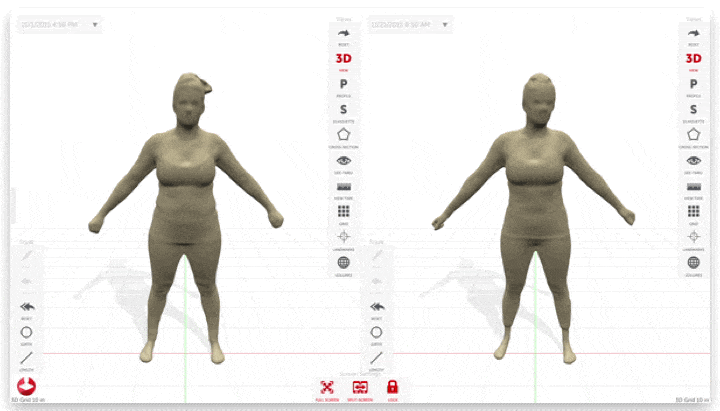
7. 3D Body Scanning
3D body scanning is one of the newest and growing trends in determining body composition. We love the way that it engages clients both visually and numerically. One of the key reasons why body scanning took first place is the fact that it builds on the power of the caliper and circumference methods without human error. Like calipers and the circumference methods, 3D body scanners (body surface imaging technology) are the most direct ways to measure body fat that you can have without taking an MRI. However, not all body scanners are built the same. Therefore, be careful and ensure that the digital tape measurements your body scanner of choice uses are precise and accurate.
How it works:
An individual stands on a rotating platform with arms stretched out and hands in fists. The scan takes about 40 seconds (one full rotation) while a 3D image of the individual is being rendered.
The Science:
Using non-invasive 3D cameras, body scanning captures surface data of an individual and renders an exact 3D model. This is accomplished with harmless infrared light that reflects off the whole body but is invisible to the eye. Digital measurements on the body's surface are then taken that replicate a tape measure but are without the imprecision of human sizes.
Additional measurements, such as volume and surface area, can be calculated as well from the 3D model. These measurements are then used to calculate body composition. The research is so promising that the NIH just approved a multi-million-dollar grant to two prominent body composition institutions to further investigate these body scanners, with the goal of commercial viability and dependability as a major motivation.
Pros: The 3D Scanner is easily transportable and, like BIA, only takes a short amount of time. 3D body scanning also captures precise measurements with camera technology, which lessens the amount of human error (as seen with calipers) and allows for accurately tracking composition changes over time (much like DEXA). The 3D visuals are extremely engaging and become a great conversation starter. Many gyms will use 3D body scanning as a customer acquisition tool to demonstrate the sophistication of their services. 3D scanning is also a great educational tool, often explaining which body fat area is difficult, but visually showing someone how their body is changing with metrics that are easier to understand (like waist circumference) helps them to connect the dots. That's especially important if their total body weight is not changing, but their shape is transforming.
Cons: Because 3D body scanning uses a non-invasive and surface-only camera, individuals wearing baggy or loose-fitting clothing will not elicit precise results. Therefore, subjects must wear form-fitting clothing. This tends to be an easy ask for women, as women are often wearing compression garments such as Pilates/yoga pants. Men, however, don't usually own compression shorts.
User Experience: It definitely ranks high on the "personal space" scale as users do not have to be touched. Also, we love the quick assessment time and ability to see the body composition output in 3D form. Those who are self-conscious about putting on revealing or tight clothing may feel uncomfortable rotating on a platform. Nonetheless, it is essential to establish your own atmosphere.
ROI: 3D images speak louder than numbers and are a great way to engage and retain members. It is an awesome value-add for PT and wellness services.
Bottom Line: Great innovative technology with precise results. It has the power to be an assessment tool and a sales and retention device. It is much easier to control for clothing requirements to get precise results than having to control for hydration with BIA or ADP.
Grade: A-
So, there you have it! All the necessary information to make an informed and insightful decision regarding body composition measurement. Remember these, and you should be well on your way to a more effective and rich measuring experience.


